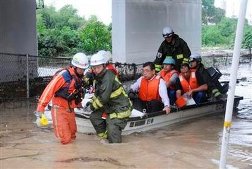 TOKYO (Reuters) – More than 1.3 million people were advised to evacuate on Tuesday as typhoon Roke approached Japan, threatening the industrial city of Nagoya with heavy rain and landslides.
TOKYO (Reuters) – More than 1.3 million people were advised to evacuate on Tuesday as typhoon Roke approached Japan, threatening the industrial city of Nagoya with heavy rain and landslides.
In Nagoya in central Japan’s Aichi prefecture about 1.1 million people were urged to evacuate, while other cities in western Japan also issued evacuation advisories on a smaller scale, public broadcaster NHK said.
No major disruptions to plant operations were reported.
The eye of the typhoon was 210 km (130 miles) east-southeast of the southern island of Tanegashima, moving east-northeast at 20 km (13 miles) per hour as of 5 p.m. (0800 GMT), the Meteorological Agency said.
“In Aichi, the heavy rain is causing some rivers to overflow. I would like to ask people to exercise the greatest caution against potential disasters from torrential rain, strong winds and high waves,” an agency official told a news conference.
The city of Nagoya asked Japan’s military, called the Self-Defense Forces, to send in troops for disaster prevention, a city official said.
Typhoon Roke follows on the heels of tropical storm Talas, which left about 100 people dead or missing in western Japan earlier this month.
Tokyo Electric Power Co said the typhoon had caused no damage to its Fukushima Daiichi nuclear power plant, where reactor cooling systems were knocked out by the March 11 earthquakes and tsunami, triggering a radiation crisis. The plant, 240 km (150 miles) north of Tokyo, was unaffected by Talas.




